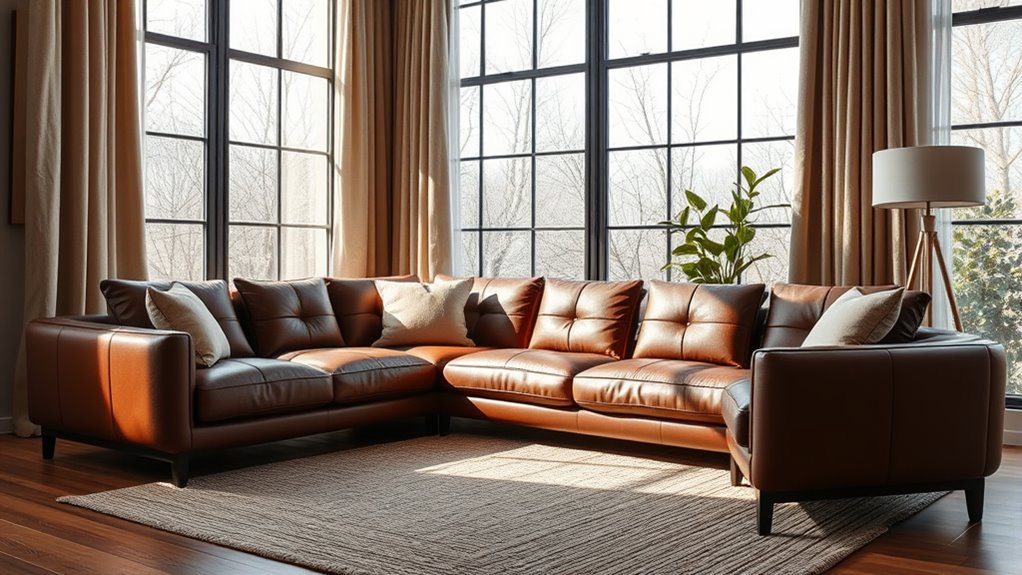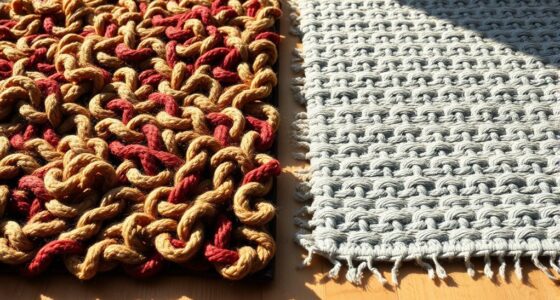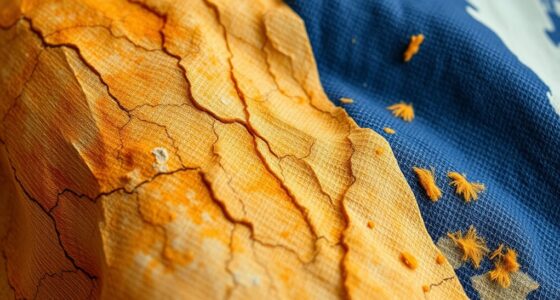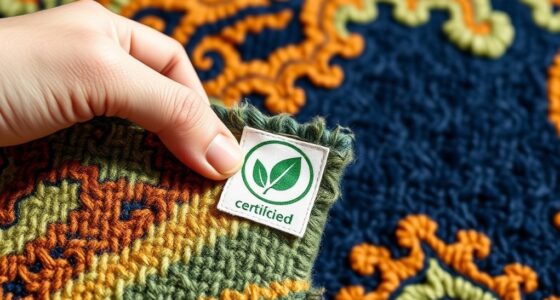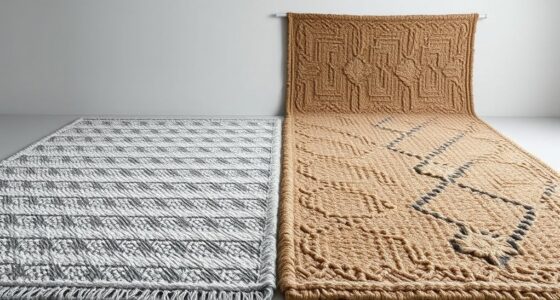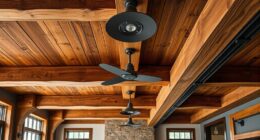Choosing vegan leather and cruelty-free textiles lets you prioritize ethical and sustainable decor without sacrificing style. These materials support animal welfare by eliminating harm and promoting responsible sourcing practices. They often mimic the look and feel of genuine leather while reducing environmental impact through innovative, eco-friendly processes. By opting for these options, you align your home with your values and set a high standard for luxury design. Discover more about how you can decorate ethically and beautifully.
Key Takeaways
- Vegan leather and cruelty-free textiles promote ethical treatment of animals and eliminate inhumane practices in high-end decor.
- These materials support sustainable sourcing, reducing environmental impact through innovative, eco-friendly production methods.
- Choosing cruelty-free fabrics ensures quality, safety, and durability comparable to traditional leather without harm.
- Using ethical textiles reflects personal values, enhancing luxury decor with social responsibility and environmental consciousness.
- Adoption of vegan and cruelty-free options sets a positive trend in sustainable, ethical luxury interior design.
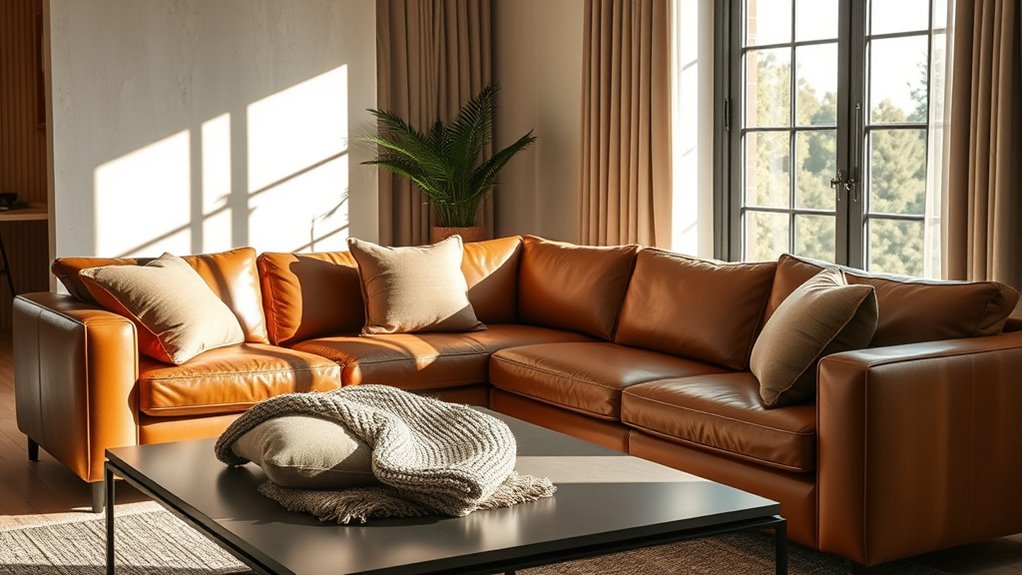
As awareness about animal welfare and environmental impact grows, more people are turning to vegan leather and cruelty-free textiles as ethical alternatives to traditional materials. You’re increasingly mindful of how your choices in high-end decor can reflect your values, and this shift extends to the materials you select. Vegan leather and cruelty-free textiles are crafted with purpose, emphasizing sustainable sourcing and a commitment to protecting animals. When you opt for these materials, you support practices that prioritize ethical treatment of animals, ensuring no harm or exploitation occurs during production. This conscious decision helps reduce demand for leather derived from animal farming, which often involves inhumane treatment and raises concerns about animal welfare.
Choosing vegan and cruelty-free textiles supports ethical treatment of animals and promotes sustainable, eco-friendly decor choices.
Sustainable sourcing is a core principle behind many cruelty-free textiles. Producers who focus on eco-friendly practices source raw materials responsibly, minimizing environmental damage and conserving resources. Instead of relying on leather, which requires extensive water, land, and chemical use, vegan alternatives often utilize innovative materials like cork, recycled plastics, or plant-based fibers. These options not only lower the ecological footprint but also promote a circular economy by repurposing waste and reducing the need for new resource extraction. When you choose products made from sustainable sources, you’re actively contributing to a healthier planet and supporting companies that prioritize environmental responsibility.
Animal welfare is at the heart of the shift toward cruelty-free textiles. Traditional leather production often involves raising and slaughtering millions of animals annually, with many facing inhumane conditions. By selecting vegan leather and cruelty-free fabrics, you eliminate the demand for animal products altogether. These alternatives are created without animal suffering, often through innovative manufacturing processes that mimic the look and feel of genuine leather without the ethical dilemmas. Knowing that your decor choices are cruelty-free can bring a sense of integrity and peace of mind, aligning your aesthetics with your values. Additionally, advances in building regulations and material testing have ensured that cruelty-free textiles meet high standards for safety and durability, making them a reliable choice for luxury decor.
Moreover, cruelty-free textiles often undergo rigorous testing to ensure safety and durability, making them a reliable choice for high-end decor. They are designed to meet the same standards as traditional materials, so you don’t have to compromise on quality or style. This blend of sustainability, ethical sourcing, and high performance makes vegan leather and cruelty-free textiles not just a trend but a responsible way to decorate your space. By choosing these materials, you demonstrate your commitment to animal welfare and environmental stewardship, setting a powerful example in the world of luxury and design.
Frequently Asked Questions
How Long Does Vegan Leather Typically Last Compared to Traditional Leather?
Vegan leather typically lasts about 3 to 5 years, slightly shorter than traditional leather, which can last 10 years or more with proper care. Durability comparison depends on factors like material quality, usage, and maintenance. Longevity factors such as exposure to sunlight, moisture, and daily wear influence how long vegan leather stays looking good. With good care, vegan leather can be a durable, ethical alternative, but it generally requires more frequent replacement.
Are Cruelty-Free Textiles as Durable as Conventional High-End Fabrics?
Cruelty-free textiles can compete with conventional fabrics in durability, depending on the design and material choice. You’ll find that synthetic durability and material longevity vary, but many high-quality cruelty-free textiles offer comparable strength and resilience. With proper care, these ethical fabrics maintain their beauty and durability over time, making them a sustainable, stylish choice for high-end decor. Don’t underestimate their endurance—they can last just as long as traditional options.
What Is the Environmental Impact of Producing Vegan Leather?
Producing vegan leather has a mixed environmental impact. It supports sustainable manufacturing by avoiding animal cruelty, but it can contribute to chemical pollution due to the use of synthetic materials and chemicals in production. You should consider these factors when choosing vegan leather, as its environmental footprint depends on the manufacturing processes. Opt for brands committed to eco-friendly practices to minimize chemical pollution and promote sustainability.
Can Cruelty-Free Textiles Be Customized for Luxury Interior Designs?
Yes, cruelty-free textiles can be customized for luxury interior designs. You have plenty of personalization options, including color customization, texture, and pattern choices, allowing you to create unique, high-end looks. These textiles are versatile and adaptable, fitting seamlessly into your design vision. By choosing cruelty-free options, you guarantee your decor aligns with ethical values without sacrificing sophistication or style, making your space both beautiful and compassionate.
Are There Any Health Concerns Associated With Vegan Leather and Synthetic Fabrics?
You might worry that vegan leather and synthetic fabrics could pose serious health risks, but the truth is, they’re generally safe if made with proper chemical safety standards. However, some materials could trigger allergen risks or skin sensitivities, especially if they contain certain dyes or chemicals. Always check for non-toxic certifications, and opt for high-quality options to minimize potential health concerns, ensuring your luxurious space remains both beautiful and safe.
Conclusion
By choosing vegan leather and cruelty-free textiles, you’re embracing a future where style and ethics go hand in hand. You can enjoy luxurious decor without the shadow of past injustices—like the dark days of the Industrial Revolution—lingering over your choices. Every eco-conscious decision you make today rewrites history, proving that sophistication doesn’t have to come at the expense of compassion. So go ahead, decorate with integrity and make your space as ethical as it is elegant.
